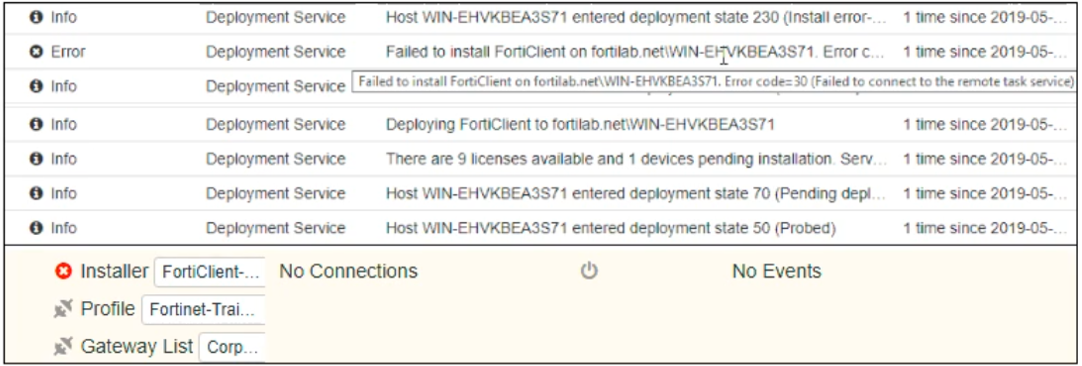Fortinet nse5-fct-7-0 practice test
NSE 5 - FortiClient EMS 7.0
Last exam update: Mar 26 ,2025
Question 1
Refer to the exhibit, which shows the output of the ZTNA traffic log on FortiGate.
What can you conclude from the log message?
- A. The remote user connection does not match the explicit proxy policy.
- B. The remote user connection does not match the ZTNA server configuration.
- C. The remote user connection does not match the ZTNA firewall policy.
- D. The remote user connection does not match the ZTNA rule configuration.
Answer:
c
Question 2
Refer to the exhibit.
An administrator has restored the modified XML configuration file to FortiClient and sees the error shown in the exhibit.
Based on the XML settings, what must the administrator do to resolve the issue with the XML configuration file?
- A. The administrator must use a password to decrypt the file.
- B. The administrator must resolve the XML syntax error.
- C. The administrator must save the file as FortiClient-config.conf.
- D. The administrator must change the file format.
Answer:
b
Question 3
Which component or device shares ZTNA tag information through Security Fabric integration?
- A. FortiClient
- B. FortiClient EMS
- C. FortiGate
- D. FortiGate Access Proxy
Answer:
b
Question 4
Refer to the exhibit.
Based on the FortiClient logs shown in the exhibit, which endpoint profile policy is currently applied to the FortiClient endpoint from the EMS server?
- A. Compliance rules default
- B. Default
- C. Default configuration policy
- D. Fortinet-Training
Answer:
d
Question 5
Refer to the exhibit, which shows FortiClient EMS deployment profiles.
When an administrator creates a deployment profile on FortiClient EMS, which statement about the deployment profile is true?
- A. Deployment-2 will install FortiClient on both the AD group and workgroup.
- B. Deployment-2 will upgrade FortiClient on both the AD group and workgroup.
- C. Deployment-1 will install FortiClient on new AD group endpoints.
- D. Deployment-1 will upgrade FortiClient only on the workgroup.
Answer:
c
Question 6
Refer to the exhibits, which show the Zero Trust Tag Monitor and the FortiClient GUI status.

Remote-Client is tagged as Remote-Users on the FortiClient EMS Zero Trust Tag Monitor.
What must an administrator do to show the tag on the FortiClient GUI?
- A. Change the FortiClient system settings to enable tag visibility.
- B. Update tagging rule logic to enable tag visibility.
- C. Change the user identity settings to enable tag visibility.
- D. Change the endpoint control setting to enable tag visibility.
Answer:
d
Question 7
An administrator configures ZTNA configuration on the FortiGate for remote users.
Which statement is true about the firewall policy?
- A. It defines the access proxy.
- B. It redirects the client request to the access proxy.
- C. It applies security profiles to protect traffic.
- D. It enforces access control.
Answer:
c
Question 8
Refer to the exhibit, which shows multiple endpoint policies on FortiClient EMS.
Which policy is applied to the endpoint in the AD group trainingAD?
- A. Both the Sales and Training policies because their priority is higher than the Default policy
- B. The Training policy
- C. The Default policy because it has the highest priority
- D. The Sales policy
Answer:
b
Question 9
Refer to the exhibit.
Based on the logs shown in the exhibit, why did FortiClient EMS fail to install FortiClient on the endpoint?
- A. The FortiClient antivirus service is not running.
- B. The Windows installer service is not running.
- C. The task scheduler service is not running.
- D. The remote registry service is not running.
Answer:
c
Question 10
Refer to the exhibits, which show a network topology diagram of ZTNA proxy access and the ZTNA rule configuration.
An administrator runs the diagnose endpoint record list CLI command on FortiGate to check Remote-Client endpoint information, however Remote-Client is not showing up in the endpoint record list.
What is the cause of this issue?

- A. Remote-Client failed the client certificate authentication.
- B. Remote-Client provided an empty client certificate to connect to the ZTNA access proxy.
- C. Remote-Client has not initiated a connection to the ZTNA access proxy.
- D. Remote-Client provided an invalid certificate to connect to the ZTNA access proxy.
Answer:
c